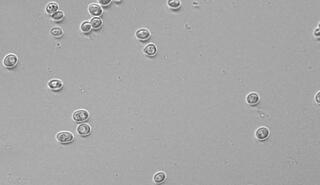Synthetic hybrids combine genomes of six yeast species

The multi-species hybrids increase genetic diversity for studying useful traits and potential mechanisms of genome evolution.
The Science
Researchers at the Great Lakes Bioenergy Research Center developed an iterative method of Hybrid Production (iHyPr) in yeasts that allows the genomes of up to six different species to be combined into a single strain. Hybrids initially grew slowly but rapidly regained fitness and adapted, even as they retained traits from multiple species. This method was used to successfully combine xylose utilization from a biofuel strain of Saccharomyces cerevisiae with cold tolerance, a trait critical for the production of many fermented beverages.
The Impact
iHyPr is a powerful addition to the yeast synthetic biology toolkit that can be used to generate and select for genome diversity, while combining industrially relevant traits from multiple parents. Moreover, the approach can be used to study potential mechanisms of species development and evolution.
Summary
Polyploidy, or multiple copies of a cell’s genome, is a commonly occurring source of natural genetic diversity. Allopolyploidy, or chromosomal variation from multiple species obtained through hybridization, facilitates differentiation and adaptation to new environments, but the tools to test its limits are lacking. Researchers developed a method to combine the genomes of multiple yeast species, termed iHyPr, as a means to tap into the rich diversity of natural isolates and create new strains with desirable traits. When making synthetic hybrids, chromosomal instability and cell size increased dramatically as additional copies of the genome were added, but the method enabled construction of synthetic hybrids from at least six species. Growth of the hybrid species was initially slow, but the strains rapidly regained fitness and adapted, yet retained traits from multiple species. In addition to combining diverse traits whose genetic basis may be uncharacterized, iHyPr can also provide insight into mechanisms of polyploidy, genome stability, and chromosome segregation.
Program Manager
N. Kent Peters
Program Manager, Office of Biological and Environmental Research
kent.peters@science.doe.gov, 301-903-5549
Corresponding Author
Chris Todd Hittinger
University of Wisconsin–Madison
cthittinger@wisc.edu
Funding
This material is based upon work supported in part by the Great Lakes Bioenergy Research Center, U.S. Department of Energy, Office of Science, Office of Biological and Environmental Research under award numbers DE-SC0018409 and DE-FC02-07ER64494; the National Science Foundation under grant number DEB-1253634; and the Robert Draper Technology Innovation Fund from the Wisconsin Alumni Research Foundation. Additional support was provided by the European Union’s Horizon 2020 research and innovation programme, grant agreement No. 747775. Work conducted by the U.S. Department of Energy Joint Genome Institute, a DOE Office of Science User Facility, is supported under contract No. DE-AC02-05CH11231.
Publications
D. Peris, et al. “Synthetic hybrids of six yeast species.” Nature Communications (2020) 11, 2085 [DOI: 10.1038/s41467-020-15559-4]
Related Links
Publication: https://www.nature.com/articles/s41467-020-15559-4
Data access information: https://www.glbrc.org/data-and-tools/glbrc-data-sets/synthetic-hybrids-six-yeast-species
News release: https://www.glbrc.org/news/researchers-create-hybrids-six-yeast-species-combine-useful-traits